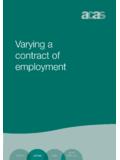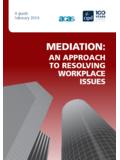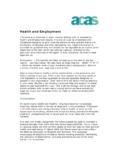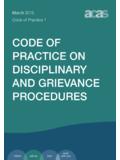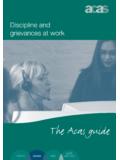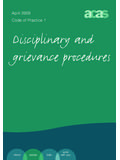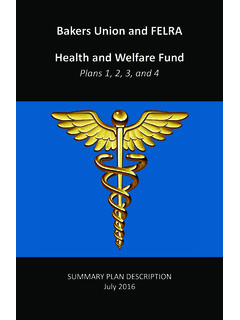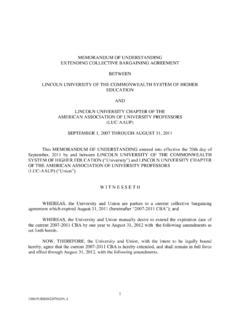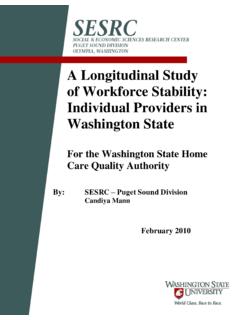Transcription of Unit 4 - Acas
1 unit 4 Employee representation As well as discussing the benefits, this unit deals with the key issues involved in having employee representatives including: numbers and constituencies election procedures period of office reporting back time and resources training encouraging employees to stand as representatives The benefits of employee representation As the introductory module emphasises, while the Regulations say that agreements can involve direct or representative methods of information and consultation, these methods should be seen in practice as complementary and mutually reinforcing. In the words of the final report of the CBITUC Productivity Challenge Best Practice Working Group, Involving individual employees or teams in decisions that affect the day to day organisation of their work helps create a culture of autonomy and responsibility. And systems for encouraging employee feedback and suggestions are key to innovation and building commitment to continuous improvement.
2 collective voice is important in building a climate of trust where individual employees are confident that their contribution will be valued. Equally valuable is its role in helping to identify shared objectives and resolve conflict. The involvement of employees representatives can create the sense of mutuality that is essential for the sustainability of new working practices the belief that both the employer and workers are reaping real benefits from improvements in work organisation. 1 Employee representation can bring considerable benefits, which are especially manifest in the case of information and consultation. Having representatives can 1 CBI-TUC. 2001. Productivity Challenge. Report of the Best Practice and Productivity Working Party. make managers seem less remote by providing easier access to them at all levels encourage employees to voice their views frankly and freely - in the absence of representatives to speak for them, employees may be reluctant to express their true opinions directly for fear that managers might interpret their comments as criticism and therefore hold this against them extend the range of the subjects over which information is given and consultation takes place it is easier to maintain confidentiality with small numbers involved where sensitive issues are involved provide an opportunity to discuss and order priorities, which increases employees sense of involvement and considerably improves effectiveness and efficiency - discussion of major matters affecting employees in general is practically very difficult to organise on a individual basis.
3 If there are as many opinions as employees, it does not help managers very much. provide a barometer of employment relations, enabling management to gauge the likely reaction of employees at an early stage in decision making improve the quality of employee input into decision making - being involved in an on-going dialogue means that employee representatives are more likely to develop the knowledge and expertise to make a meaningful contribution develop the skills of managers, as well as employee representatives, in such areas as listening, diplomacy, making presentations and problem solving help to build trust and co-operation and thereby contribute to better understanding of the need for change, increased acceptability of decisions and improved business performance. Against this background, this module looks at the issues involved in securing effective employee representatives for the purposes of information and consultation.
4 Numbers and constituencies In deciding the numbers of employee representatives, you are strongly advised to adopt what might be described as a constituency-based approach. The appropriate number of representatives, in other words, should depend on the structure of the organisation, with each major grouping and/or location (the constituency ) having their own representatives. For example, if there are 200 employees, all doing exactly the same job, 3 representatives might be adequate. But if there are 200 employees divided into five major groups or units, each doing different jobs, there will be a need for a minimum of 5 representatives. Employees need to feel that their interests are being represented and management needs to know that they are getting the true picture. If the constituency is too large, it will be difficult for representatives to communicate effectively and seek feedback from their constituents.
5 The same will be true if representatives have to cover too many different groups. The basis of constituencies will need to reflect the individual circumstances of the organisation. The basis could be occupational group or grade or function or operation ( production or shop floor, warehouse, office); it could be shift patterns (constituencies of night and day shift workers, for example) or production line, perhaps with one representative per line; or by geographical area. It could also reflect the gender and race of your workforce. Indeed, paying attention to these considerations would be a very tangible way of promoting diversity and ensuring equality of opportunity more generally. Ideally, every effort should be made to accommodate distinct groups of employees reflecting the range of different interests and needs. Also important is to build in arrangements for regular review. Constituencies will almost certainly change in line with developments in the business more generally.
6 Election procedures It is not appropriate for managers to appoint employee representatives, although it may be necessary in some workplaces to get representative-based arrangements off the ground. Employee representatives need to be genuinely representative of their constituencies, which normally means holding elections. Furthermore, the arrangements need to be transparent and acceptable to employees, with the outcomes seen to be demonstrably fair. In practice, there will be two main types of situation, depending on whether trade unions are recognised for the purposes of collective bargaining . Undertakings with trade union recognition In undertakings where trade unions are recognised for the purposes of collective bargaining , the arrangements for employee representation are likely to reflect union constitutions and/or collective agreements. Typically, trade union members in a constituency will elect their representatives on the basis of these procedures, with management being informed of the outcome.
7 Effectively, therefore, in carrying out their role, these individuals will be representing their trade union as well as the immediate members. This means that they will not only enjoy the support of their union in terms of training and advice, but also will be subject to the discipline of its internal codes of conduct. There could be complications where trade union recognition affects only some groups of employees and/or where membership among employees in the bargaining group is relatively low. In practice, few UK undertakings these days have 100 per cent coverage of collective bargaining or union membership. The main options for handling mixed constituencies of union and non-unionised groups are considered in Methods and structures (Appendix ). Groups without trade union recognition In the case of undertakings or groups of employees with no trade union recognition or history of employee representation, the following provisions are recommended.
8 These build on the existing legislation dealing with collective redundancy, transfer of undertakings and workforce agreements under the 1998 Working Time regulations. They will need to be brought into line, though, with the arrangements covering union representatives in undertakings with mixed constituencies it s not sensible to have marked and certainly unjustifiable differences between union and non-union representatives. The number of representatives to be elected should reflect the make-up of the workforce as a general principle, there should be at least one representative from each of the major groups. The candidates for election as employee representatives should be relevant members of the workforce and of the particular group of employees on the date of the election. Any specific criteria for election such as experience and employment status should be clearlyspelt out. No affected employee should be unreasonably excluded from standing for election.
9 All affected employees on the date of the election should be entitled to vote. The employees entitled to vote should be able to vote for as many candidates as there are representatives to be elected; or, if there are to be representatives for particular classes of employees, for as many candidates as there are representatives to be elected to represent their particular class of employee. Where an employee representative ceases to act and, in consequence, certain employees are no longer represented, another election should be held which satisfies the rules. The election should be conducted so that: those voting do so in secret, and the votes are accurately counted. The best way of ensuring an open and fair nomination and election process is to involve an independent scrutiniser. Acas can be contacted for help and advice. Higher level representatives A further issue is to be decided in undertakings that have arrangements involving two or more tiers.
10 It is the procedure to be adopted in electing representatives to the higher tiers. It could arise in the undertaking with several divisions and/or establishments under its control. Or it could arise where the undertaking is one of a number of undertakings under the control of an even larger entity with perhaps a European Works Council at the apex. Here the most practical outcome is to agree a procedure that provides for the representatives at the lower level to elect one or more of their number to go forward as representatives at the next level and so on. Numbers should reflect constituencies, which should take into similar considerations to those discussed above. The same criteria in terms of eligibility should also apply along with an open and fair nomination and election process. Period of office When considering issues relating to the period of office and arrangements for the retirement of representatives, conflicting pressures for continuity and change come to the fore.

